Cloud Computing Security Analysis
VerifiedAdded on 2020/02/24
|14
|3393
|85
AI Summary
This assignment delves into the critical topic of cloud computing security. It examines various security threats and vulnerabilities inherent in cloud environments, including data breaches, unauthorized access, and malicious attacks. Students will analyze existing security measures and propose strategies to mitigate these risks. The focus is on understanding the complexities of securing sensitive information and ensuring the integrity of cloud-based systems.
Contribute Materials
Your contribution can guide someone’s learning journey. Share your
documents today.
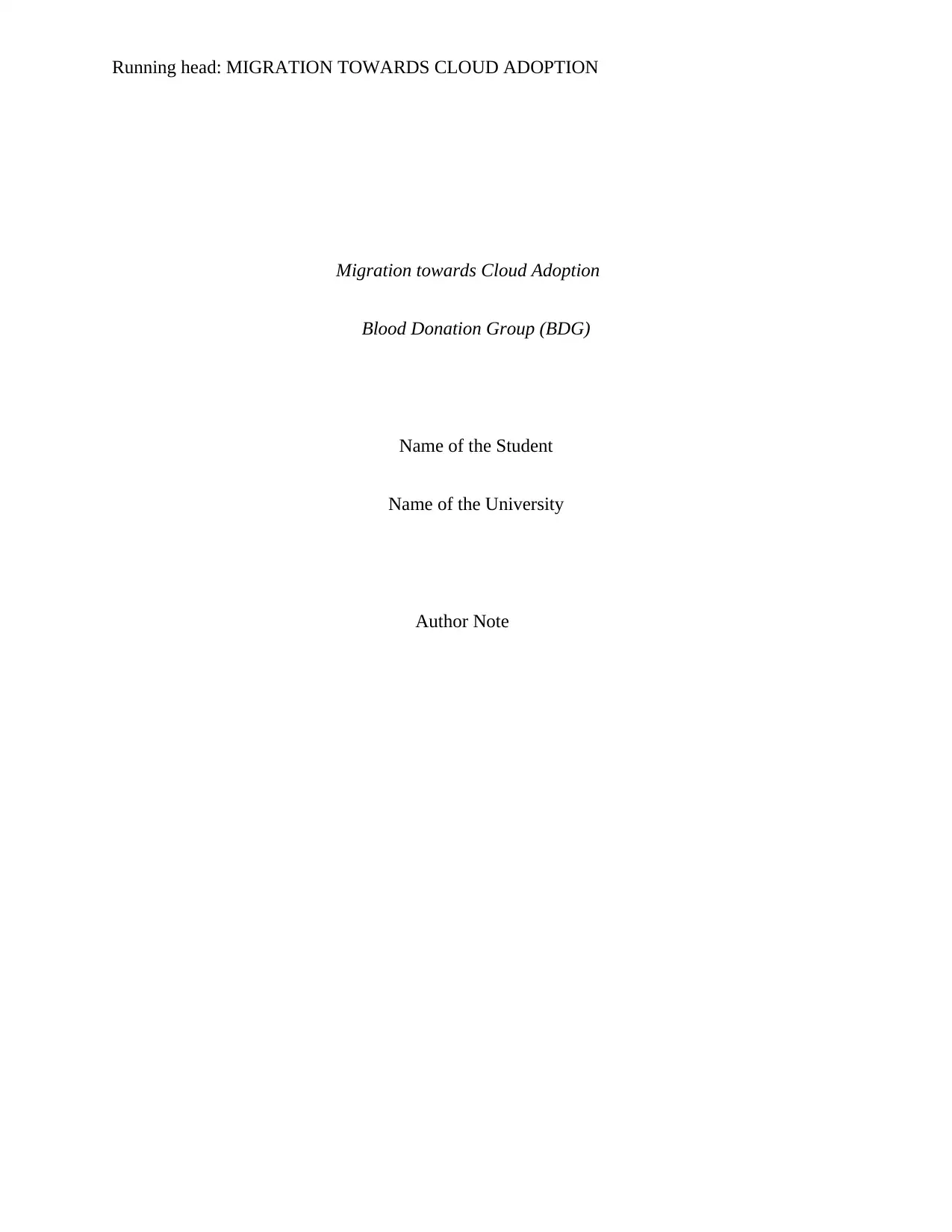
Running head: MIGRATION TOWARDS CLOUD ADOPTION
Migration towards Cloud Adoption
Blood Donation Group (BDG)
Name of the Student
Name of the University
Author Note
Migration towards Cloud Adoption
Blood Donation Group (BDG)
Name of the Student
Name of the University
Author Note
Secure Best Marks with AI Grader
Need help grading? Try our AI Grader for instant feedback on your assignments.
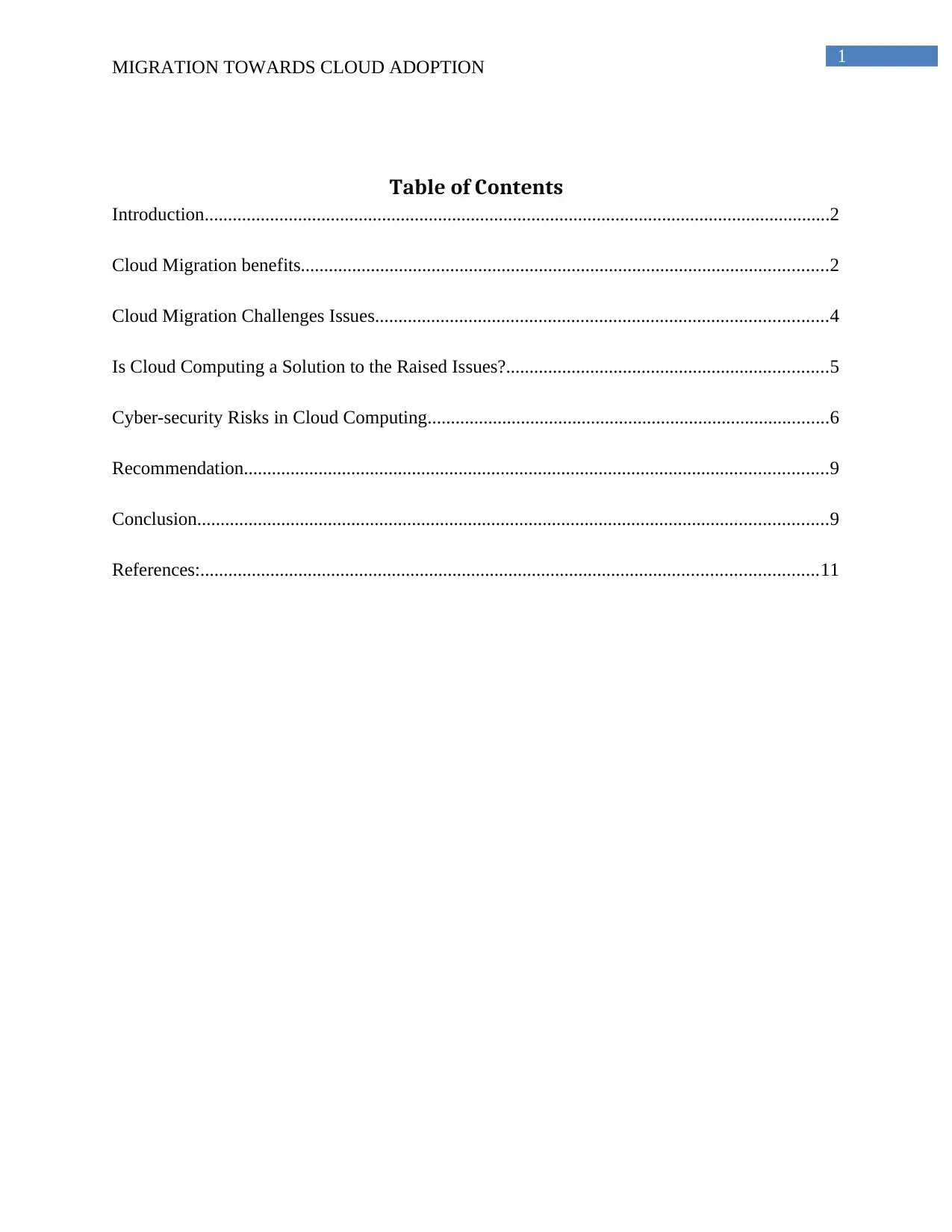
1
MIGRATION TOWARDS CLOUD ADOPTION
Table of Contents
Introduction......................................................................................................................................2
Cloud Migration benefits.................................................................................................................2
Cloud Migration Challenges Issues.................................................................................................4
Is Cloud Computing a Solution to the Raised Issues?.....................................................................5
Cyber-security Risks in Cloud Computing......................................................................................6
Recommendation.............................................................................................................................9
Conclusion.......................................................................................................................................9
References:....................................................................................................................................11
MIGRATION TOWARDS CLOUD ADOPTION
Table of Contents
Introduction......................................................................................................................................2
Cloud Migration benefits.................................................................................................................2
Cloud Migration Challenges Issues.................................................................................................4
Is Cloud Computing a Solution to the Raised Issues?.....................................................................5
Cyber-security Risks in Cloud Computing......................................................................................6
Recommendation.............................................................................................................................9
Conclusion.......................................................................................................................................9
References:....................................................................................................................................11
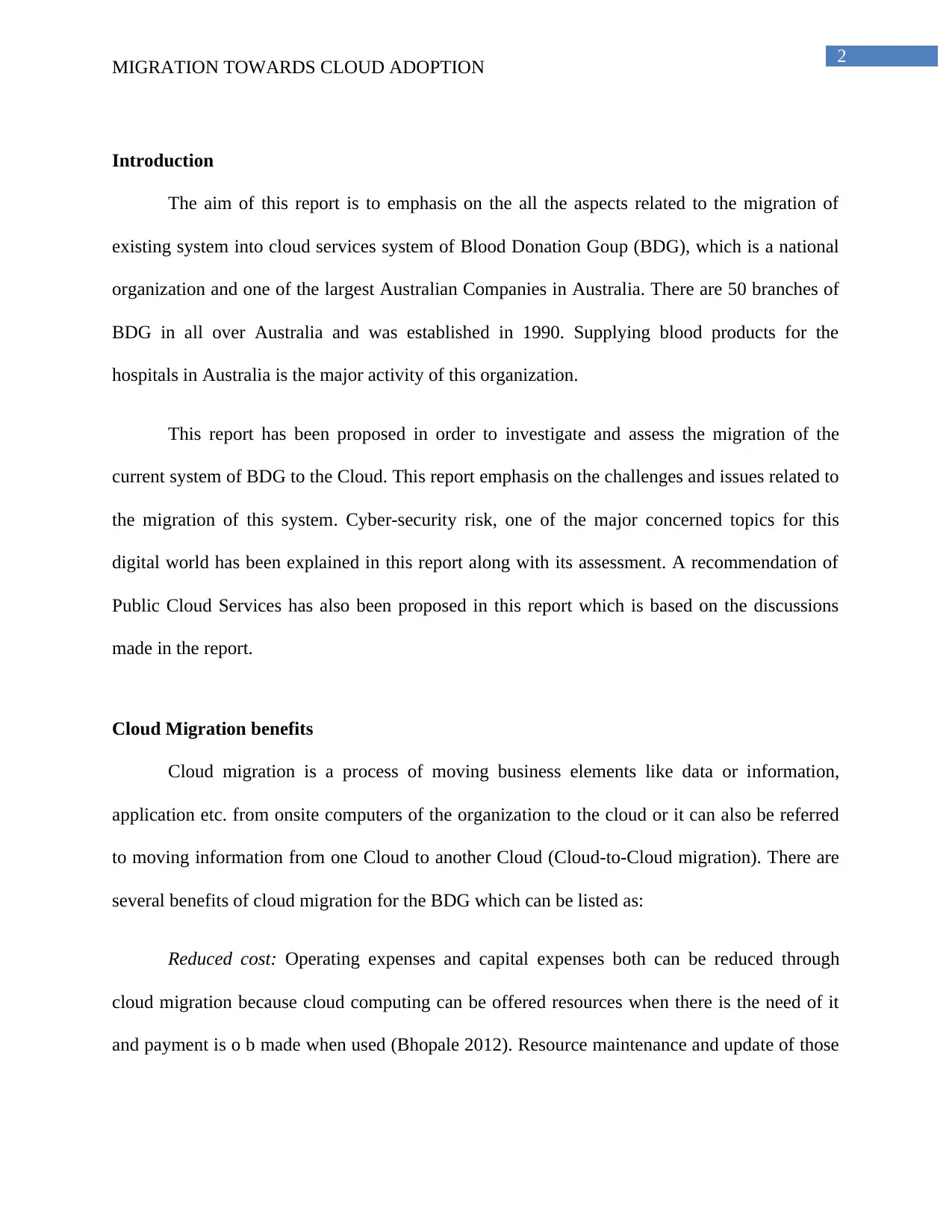
2
MIGRATION TOWARDS CLOUD ADOPTION
Introduction
The aim of this report is to emphasis on the all the aspects related to the migration of
existing system into cloud services system of Blood Donation Goup (BDG), which is a national
organization and one of the largest Australian Companies in Australia. There are 50 branches of
BDG in all over Australia and was established in 1990. Supplying blood products for the
hospitals in Australia is the major activity of this organization.
This report has been proposed in order to investigate and assess the migration of the
current system of BDG to the Cloud. This report emphasis on the challenges and issues related to
the migration of this system. Cyber-security risk, one of the major concerned topics for this
digital world has been explained in this report along with its assessment. A recommendation of
Public Cloud Services has also been proposed in this report which is based on the discussions
made in the report.
Cloud Migration benefits
Cloud migration is a process of moving business elements like data or information,
application etc. from onsite computers of the organization to the cloud or it can also be referred
to moving information from one Cloud to another Cloud (Cloud-to-Cloud migration). There are
several benefits of cloud migration for the BDG which can be listed as:
Reduced cost: Operating expenses and capital expenses both can be reduced through
cloud migration because cloud computing can be offered resources when there is the need of it
and payment is o b made when used (Bhopale 2012). Resource maintenance and update of those
MIGRATION TOWARDS CLOUD ADOPTION
Introduction
The aim of this report is to emphasis on the all the aspects related to the migration of
existing system into cloud services system of Blood Donation Goup (BDG), which is a national
organization and one of the largest Australian Companies in Australia. There are 50 branches of
BDG in all over Australia and was established in 1990. Supplying blood products for the
hospitals in Australia is the major activity of this organization.
This report has been proposed in order to investigate and assess the migration of the
current system of BDG to the Cloud. This report emphasis on the challenges and issues related to
the migration of this system. Cyber-security risk, one of the major concerned topics for this
digital world has been explained in this report along with its assessment. A recommendation of
Public Cloud Services has also been proposed in this report which is based on the discussions
made in the report.
Cloud Migration benefits
Cloud migration is a process of moving business elements like data or information,
application etc. from onsite computers of the organization to the cloud or it can also be referred
to moving information from one Cloud to another Cloud (Cloud-to-Cloud migration). There are
several benefits of cloud migration for the BDG which can be listed as:
Reduced cost: Operating expenses and capital expenses both can be reduced through
cloud migration because cloud computing can be offered resources when there is the need of it
and payment is o b made when used (Bhopale 2012). Resource maintenance and update of those
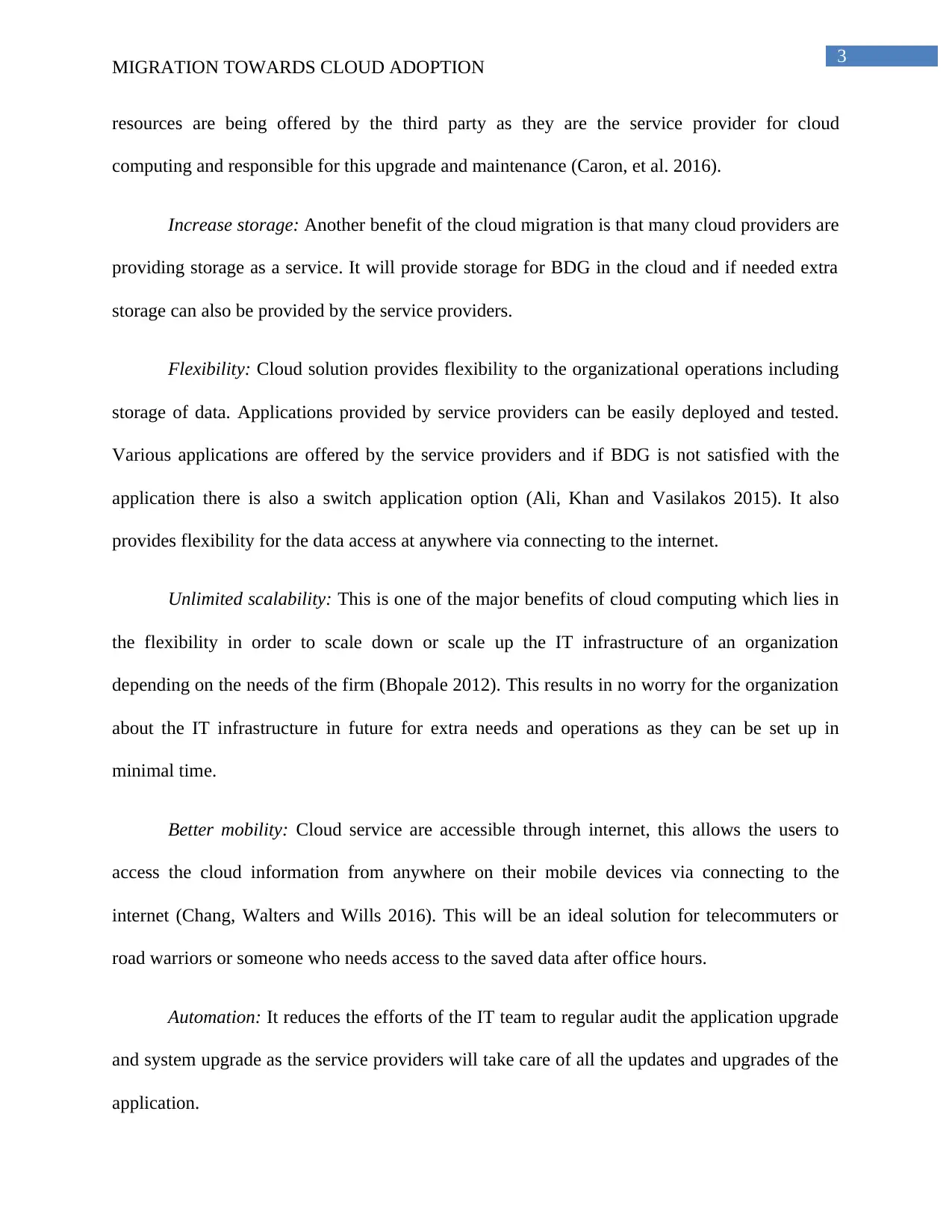
3
MIGRATION TOWARDS CLOUD ADOPTION
resources are being offered by the third party as they are the service provider for cloud
computing and responsible for this upgrade and maintenance (Caron, et al. 2016).
Increase storage: Another benefit of the cloud migration is that many cloud providers are
providing storage as a service. It will provide storage for BDG in the cloud and if needed extra
storage can also be provided by the service providers.
Flexibility: Cloud solution provides flexibility to the organizational operations including
storage of data. Applications provided by service providers can be easily deployed and tested.
Various applications are offered by the service providers and if BDG is not satisfied with the
application there is also a switch application option (Ali, Khan and Vasilakos 2015). It also
provides flexibility for the data access at anywhere via connecting to the internet.
Unlimited scalability: This is one of the major benefits of cloud computing which lies in
the flexibility in order to scale down or scale up the IT infrastructure of an organization
depending on the needs of the firm (Bhopale 2012). This results in no worry for the organization
about the IT infrastructure in future for extra needs and operations as they can be set up in
minimal time.
Better mobility: Cloud service are accessible through internet, this allows the users to
access the cloud information from anywhere on their mobile devices via connecting to the
internet (Chang, Walters and Wills 2016). This will be an ideal solution for telecommuters or
road warriors or someone who needs access to the saved data after office hours.
Automation: It reduces the efforts of the IT team to regular audit the application upgrade
and system upgrade as the service providers will take care of all the updates and upgrades of the
application.
MIGRATION TOWARDS CLOUD ADOPTION
resources are being offered by the third party as they are the service provider for cloud
computing and responsible for this upgrade and maintenance (Caron, et al. 2016).
Increase storage: Another benefit of the cloud migration is that many cloud providers are
providing storage as a service. It will provide storage for BDG in the cloud and if needed extra
storage can also be provided by the service providers.
Flexibility: Cloud solution provides flexibility to the organizational operations including
storage of data. Applications provided by service providers can be easily deployed and tested.
Various applications are offered by the service providers and if BDG is not satisfied with the
application there is also a switch application option (Ali, Khan and Vasilakos 2015). It also
provides flexibility for the data access at anywhere via connecting to the internet.
Unlimited scalability: This is one of the major benefits of cloud computing which lies in
the flexibility in order to scale down or scale up the IT infrastructure of an organization
depending on the needs of the firm (Bhopale 2012). This results in no worry for the organization
about the IT infrastructure in future for extra needs and operations as they can be set up in
minimal time.
Better mobility: Cloud service are accessible through internet, this allows the users to
access the cloud information from anywhere on their mobile devices via connecting to the
internet (Chang, Walters and Wills 2016). This will be an ideal solution for telecommuters or
road warriors or someone who needs access to the saved data after office hours.
Automation: It reduces the efforts of the IT team to regular audit the application upgrade
and system upgrade as the service providers will take care of all the updates and upgrades of the
application.
Secure Best Marks with AI Grader
Need help grading? Try our AI Grader for instant feedback on your assignments.
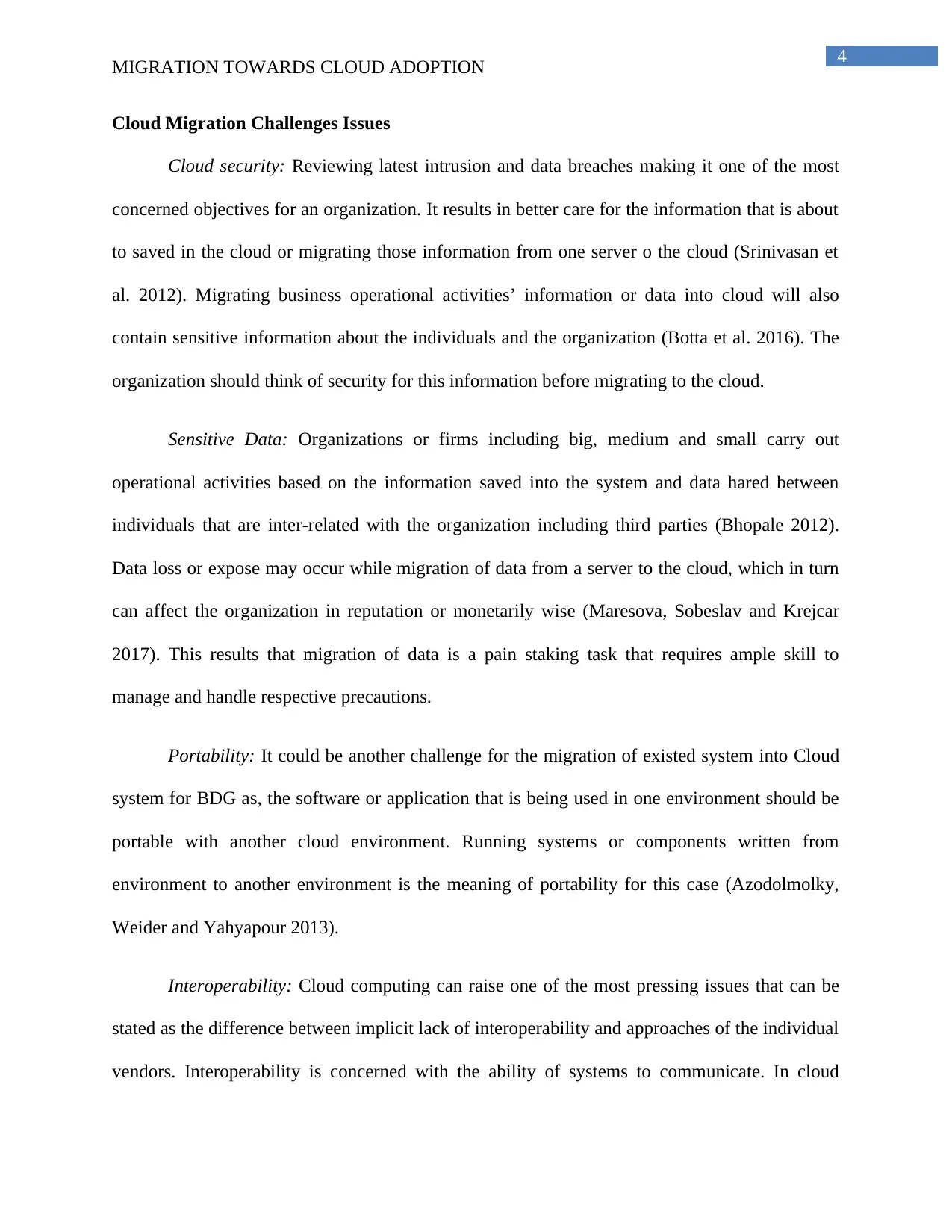
4
MIGRATION TOWARDS CLOUD ADOPTION
Cloud Migration Challenges Issues
Cloud security: Reviewing latest intrusion and data breaches making it one of the most
concerned objectives for an organization. It results in better care for the information that is about
to saved in the cloud or migrating those information from one server o the cloud (Srinivasan et
al. 2012). Migrating business operational activities’ information or data into cloud will also
contain sensitive information about the individuals and the organization (Botta et al. 2016). The
organization should think of security for this information before migrating to the cloud.
Sensitive Data: Organizations or firms including big, medium and small carry out
operational activities based on the information saved into the system and data hared between
individuals that are inter-related with the organization including third parties (Bhopale 2012).
Data loss or expose may occur while migration of data from a server to the cloud, which in turn
can affect the organization in reputation or monetarily wise (Maresova, Sobeslav and Krejcar
2017). This results that migration of data is a pain staking task that requires ample skill to
manage and handle respective precautions.
Portability: It could be another challenge for the migration of existed system into Cloud
system for BDG as, the software or application that is being used in one environment should be
portable with another cloud environment. Running systems or components written from
environment to another environment is the meaning of portability for this case (Azodolmolky,
Weider and Yahyapour 2013).
Interoperability: Cloud computing can raise one of the most pressing issues that can be
stated as the difference between implicit lack of interoperability and approaches of the individual
vendors. Interoperability is concerned with the ability of systems to communicate. In cloud
MIGRATION TOWARDS CLOUD ADOPTION
Cloud Migration Challenges Issues
Cloud security: Reviewing latest intrusion and data breaches making it one of the most
concerned objectives for an organization. It results in better care for the information that is about
to saved in the cloud or migrating those information from one server o the cloud (Srinivasan et
al. 2012). Migrating business operational activities’ information or data into cloud will also
contain sensitive information about the individuals and the organization (Botta et al. 2016). The
organization should think of security for this information before migrating to the cloud.
Sensitive Data: Organizations or firms including big, medium and small carry out
operational activities based on the information saved into the system and data hared between
individuals that are inter-related with the organization including third parties (Bhopale 2012).
Data loss or expose may occur while migration of data from a server to the cloud, which in turn
can affect the organization in reputation or monetarily wise (Maresova, Sobeslav and Krejcar
2017). This results that migration of data is a pain staking task that requires ample skill to
manage and handle respective precautions.
Portability: It could be another challenge for the migration of existed system into Cloud
system for BDG as, the software or application that is being used in one environment should be
portable with another cloud environment. Running systems or components written from
environment to another environment is the meaning of portability for this case (Azodolmolky,
Weider and Yahyapour 2013).
Interoperability: Cloud computing can raise one of the most pressing issues that can be
stated as the difference between implicit lack of interoperability and approaches of the individual
vendors. Interoperability is concerned with the ability of systems to communicate. In cloud
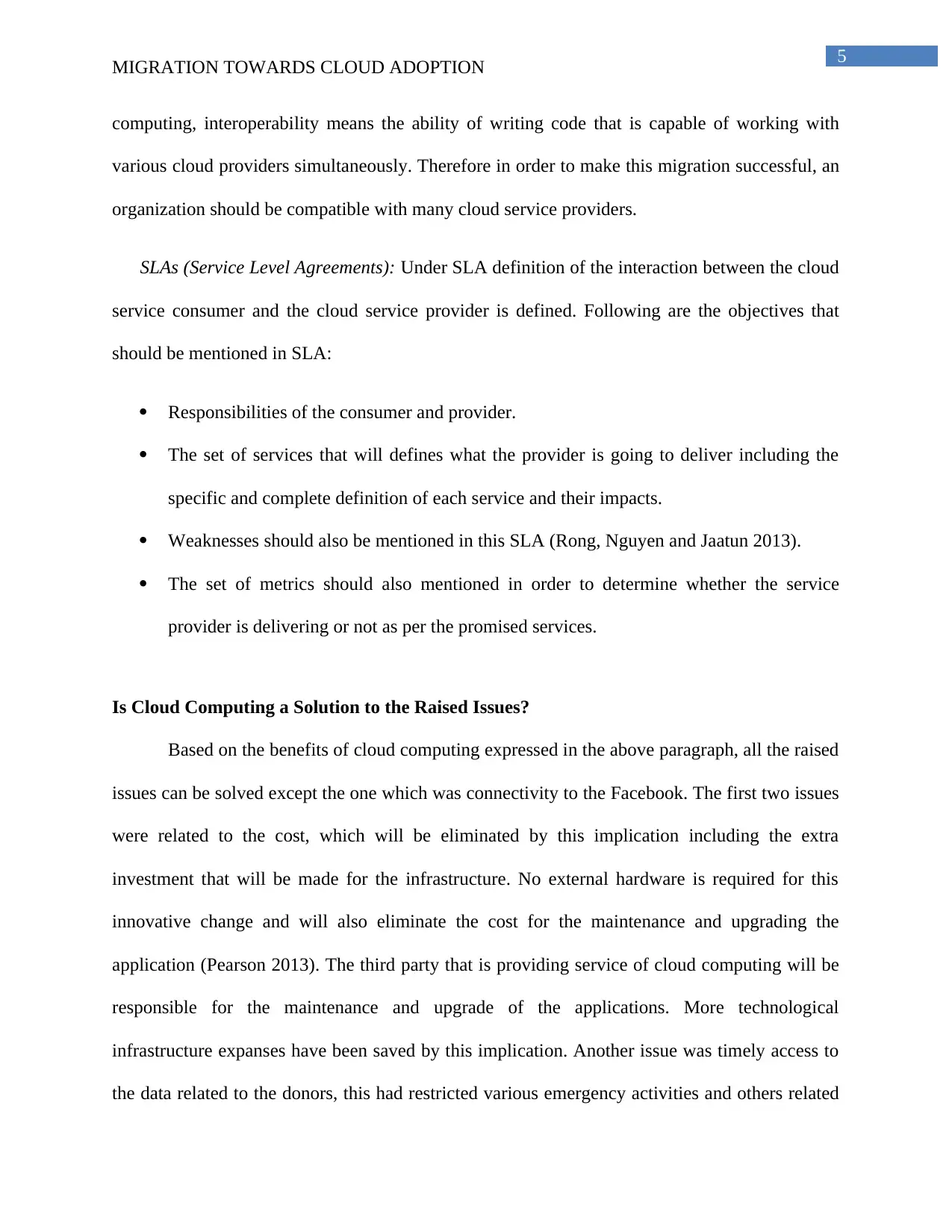
5
MIGRATION TOWARDS CLOUD ADOPTION
computing, interoperability means the ability of writing code that is capable of working with
various cloud providers simultaneously. Therefore in order to make this migration successful, an
organization should be compatible with many cloud service providers.
SLAs (Service Level Agreements): Under SLA definition of the interaction between the cloud
service consumer and the cloud service provider is defined. Following are the objectives that
should be mentioned in SLA:
Responsibilities of the consumer and provider.
The set of services that will defines what the provider is going to deliver including the
specific and complete definition of each service and their impacts.
Weaknesses should also be mentioned in this SLA (Rong, Nguyen and Jaatun 2013).
The set of metrics should also mentioned in order to determine whether the service
provider is delivering or not as per the promised services.
Is Cloud Computing a Solution to the Raised Issues?
Based on the benefits of cloud computing expressed in the above paragraph, all the raised
issues can be solved except the one which was connectivity to the Facebook. The first two issues
were related to the cost, which will be eliminated by this implication including the extra
investment that will be made for the infrastructure. No external hardware is required for this
innovative change and will also eliminate the cost for the maintenance and upgrading the
application (Pearson 2013). The third party that is providing service of cloud computing will be
responsible for the maintenance and upgrade of the applications. More technological
infrastructure expanses have been saved by this implication. Another issue was timely access to
the data related to the donors, this had restricted various emergency activities and others related
MIGRATION TOWARDS CLOUD ADOPTION
computing, interoperability means the ability of writing code that is capable of working with
various cloud providers simultaneously. Therefore in order to make this migration successful, an
organization should be compatible with many cloud service providers.
SLAs (Service Level Agreements): Under SLA definition of the interaction between the cloud
service consumer and the cloud service provider is defined. Following are the objectives that
should be mentioned in SLA:
Responsibilities of the consumer and provider.
The set of services that will defines what the provider is going to deliver including the
specific and complete definition of each service and their impacts.
Weaknesses should also be mentioned in this SLA (Rong, Nguyen and Jaatun 2013).
The set of metrics should also mentioned in order to determine whether the service
provider is delivering or not as per the promised services.
Is Cloud Computing a Solution to the Raised Issues?
Based on the benefits of cloud computing expressed in the above paragraph, all the raised
issues can be solved except the one which was connectivity to the Facebook. The first two issues
were related to the cost, which will be eliminated by this implication including the extra
investment that will be made for the infrastructure. No external hardware is required for this
innovative change and will also eliminate the cost for the maintenance and upgrading the
application (Pearson 2013). The third party that is providing service of cloud computing will be
responsible for the maintenance and upgrade of the applications. More technological
infrastructure expanses have been saved by this implication. Another issue was timely access to
the data related to the donors, this had restricted various emergency activities and others related
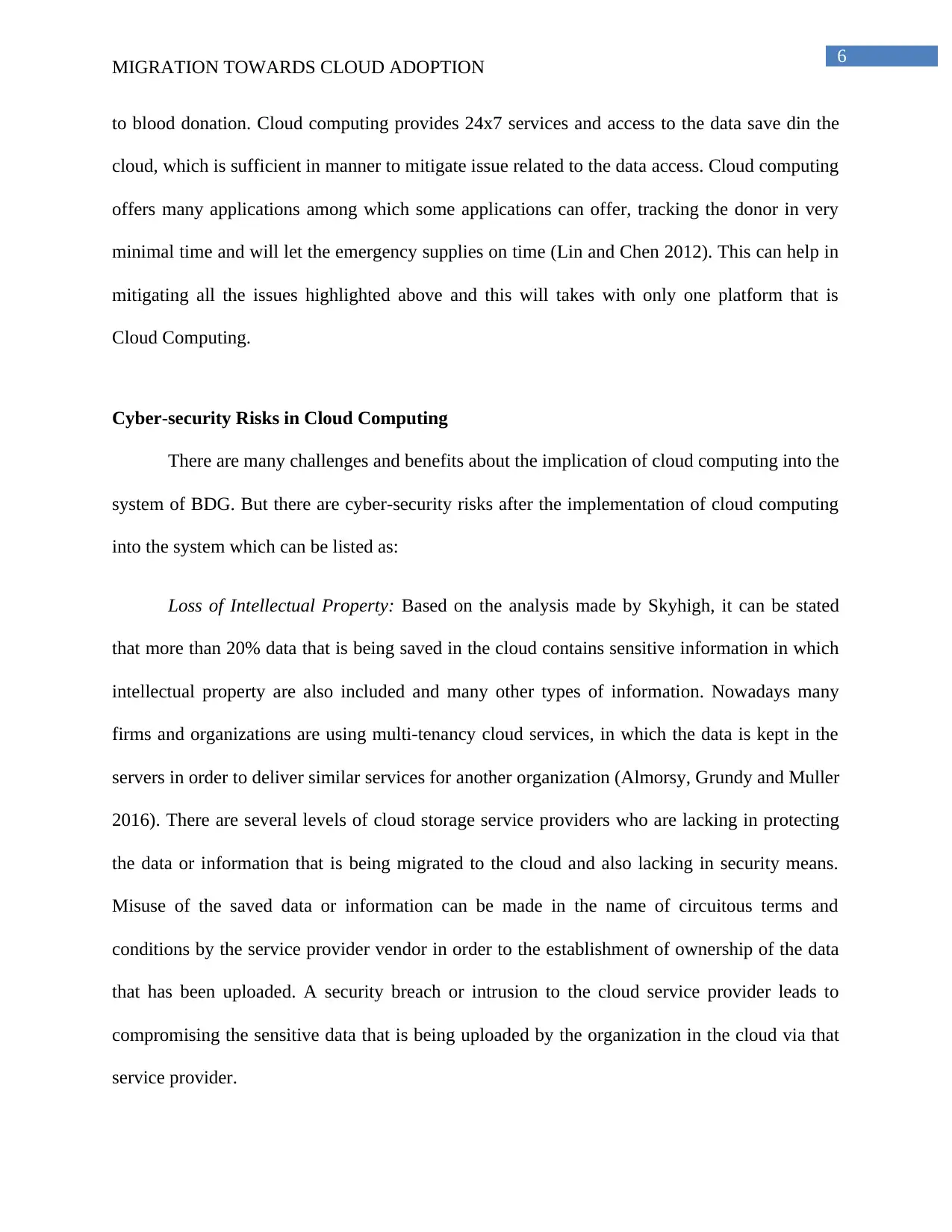
6
MIGRATION TOWARDS CLOUD ADOPTION
to blood donation. Cloud computing provides 24x7 services and access to the data save din the
cloud, which is sufficient in manner to mitigate issue related to the data access. Cloud computing
offers many applications among which some applications can offer, tracking the donor in very
minimal time and will let the emergency supplies on time (Lin and Chen 2012). This can help in
mitigating all the issues highlighted above and this will takes with only one platform that is
Cloud Computing.
Cyber-security Risks in Cloud Computing
There are many challenges and benefits about the implication of cloud computing into the
system of BDG. But there are cyber-security risks after the implementation of cloud computing
into the system which can be listed as:
Loss of Intellectual Property: Based on the analysis made by Skyhigh, it can be stated
that more than 20% data that is being saved in the cloud contains sensitive information in which
intellectual property are also included and many other types of information. Nowadays many
firms and organizations are using multi-tenancy cloud services, in which the data is kept in the
servers in order to deliver similar services for another organization (Almorsy, Grundy and Muller
2016). There are several levels of cloud storage service providers who are lacking in protecting
the data or information that is being migrated to the cloud and also lacking in security means.
Misuse of the saved data or information can be made in the name of circuitous terms and
conditions by the service provider vendor in order to the establishment of ownership of the data
that has been uploaded. A security breach or intrusion to the cloud service provider leads to
compromising the sensitive data that is being uploaded by the organization in the cloud via that
service provider.
MIGRATION TOWARDS CLOUD ADOPTION
to blood donation. Cloud computing provides 24x7 services and access to the data save din the
cloud, which is sufficient in manner to mitigate issue related to the data access. Cloud computing
offers many applications among which some applications can offer, tracking the donor in very
minimal time and will let the emergency supplies on time (Lin and Chen 2012). This can help in
mitigating all the issues highlighted above and this will takes with only one platform that is
Cloud Computing.
Cyber-security Risks in Cloud Computing
There are many challenges and benefits about the implication of cloud computing into the
system of BDG. But there are cyber-security risks after the implementation of cloud computing
into the system which can be listed as:
Loss of Intellectual Property: Based on the analysis made by Skyhigh, it can be stated
that more than 20% data that is being saved in the cloud contains sensitive information in which
intellectual property are also included and many other types of information. Nowadays many
firms and organizations are using multi-tenancy cloud services, in which the data is kept in the
servers in order to deliver similar services for another organization (Almorsy, Grundy and Muller
2016). There are several levels of cloud storage service providers who are lacking in protecting
the data or information that is being migrated to the cloud and also lacking in security means.
Misuse of the saved data or information can be made in the name of circuitous terms and
conditions by the service provider vendor in order to the establishment of ownership of the data
that has been uploaded. A security breach or intrusion to the cloud service provider leads to
compromising the sensitive data that is being uploaded by the organization in the cloud via that
service provider.
Paraphrase This Document
Need a fresh take? Get an instant paraphrase of this document with our AI Paraphraser
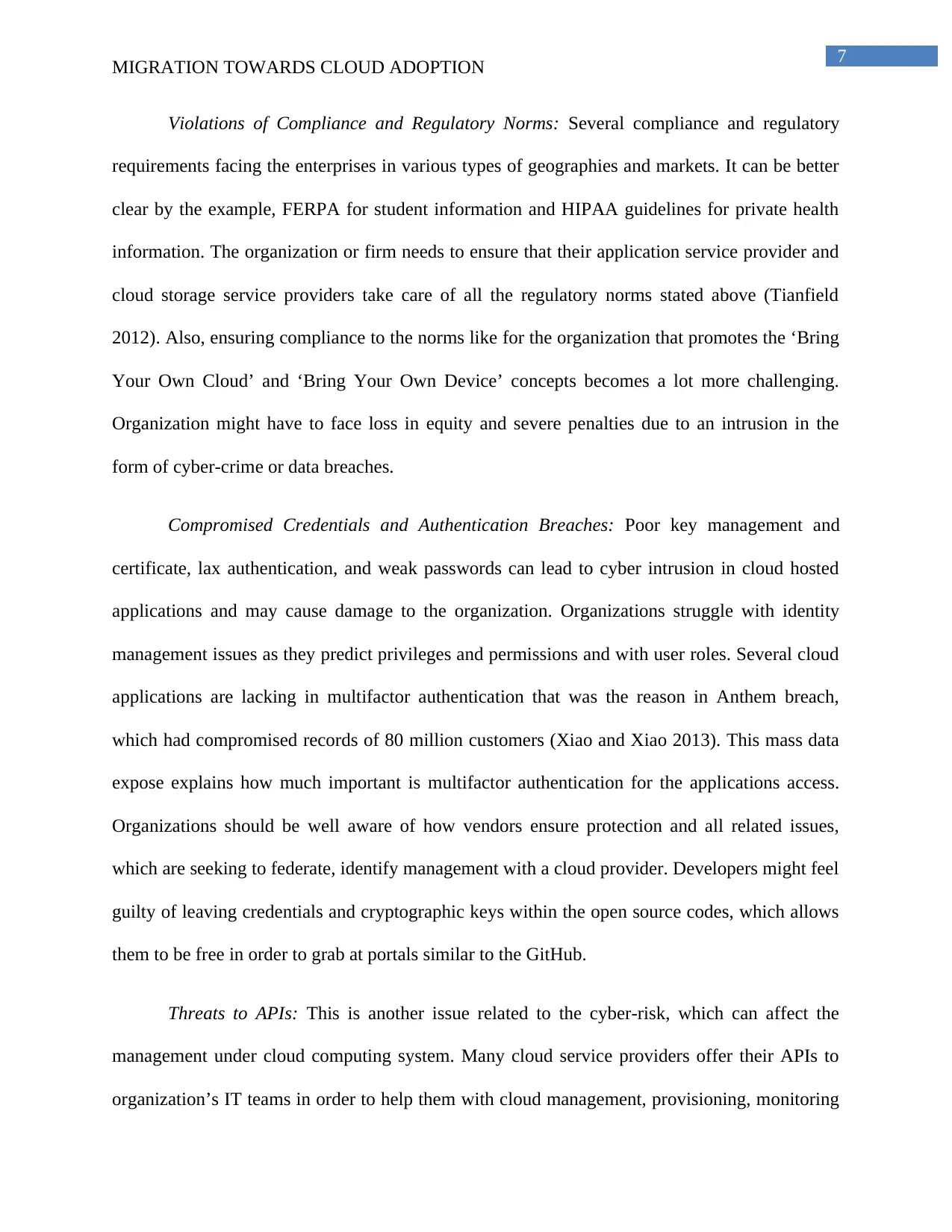
7
MIGRATION TOWARDS CLOUD ADOPTION
Violations of Compliance and Regulatory Norms: Several compliance and regulatory
requirements facing the enterprises in various types of geographies and markets. It can be better
clear by the example, FERPA for student information and HIPAA guidelines for private health
information. The organization or firm needs to ensure that their application service provider and
cloud storage service providers take care of all the regulatory norms stated above (Tianfield
2012). Also, ensuring compliance to the norms like for the organization that promotes the ‘Bring
Your Own Cloud’ and ‘Bring Your Own Device’ concepts becomes a lot more challenging.
Organization might have to face loss in equity and severe penalties due to an intrusion in the
form of cyber-crime or data breaches.
Compromised Credentials and Authentication Breaches: Poor key management and
certificate, lax authentication, and weak passwords can lead to cyber intrusion in cloud hosted
applications and may cause damage to the organization. Organizations struggle with identity
management issues as they predict privileges and permissions and with user roles. Several cloud
applications are lacking in multifactor authentication that was the reason in Anthem breach,
which had compromised records of 80 million customers (Xiao and Xiao 2013). This mass data
expose explains how much important is multifactor authentication for the applications access.
Organizations should be well aware of how vendors ensure protection and all related issues,
which are seeking to federate, identify management with a cloud provider. Developers might feel
guilty of leaving credentials and cryptographic keys within the open source codes, which allows
them to be free in order to grab at portals similar to the GitHub.
Threats to APIs: This is another issue related to the cyber-risk, which can affect the
management under cloud computing system. Many cloud service providers offer their APIs to
organization’s IT teams in order to help them with cloud management, provisioning, monitoring
MIGRATION TOWARDS CLOUD ADOPTION
Violations of Compliance and Regulatory Norms: Several compliance and regulatory
requirements facing the enterprises in various types of geographies and markets. It can be better
clear by the example, FERPA for student information and HIPAA guidelines for private health
information. The organization or firm needs to ensure that their application service provider and
cloud storage service providers take care of all the regulatory norms stated above (Tianfield
2012). Also, ensuring compliance to the norms like for the organization that promotes the ‘Bring
Your Own Cloud’ and ‘Bring Your Own Device’ concepts becomes a lot more challenging.
Organization might have to face loss in equity and severe penalties due to an intrusion in the
form of cyber-crime or data breaches.
Compromised Credentials and Authentication Breaches: Poor key management and
certificate, lax authentication, and weak passwords can lead to cyber intrusion in cloud hosted
applications and may cause damage to the organization. Organizations struggle with identity
management issues as they predict privileges and permissions and with user roles. Several cloud
applications are lacking in multifactor authentication that was the reason in Anthem breach,
which had compromised records of 80 million customers (Xiao and Xiao 2013). This mass data
expose explains how much important is multifactor authentication for the applications access.
Organizations should be well aware of how vendors ensure protection and all related issues,
which are seeking to federate, identify management with a cloud provider. Developers might feel
guilty of leaving credentials and cryptographic keys within the open source codes, which allows
them to be free in order to grab at portals similar to the GitHub.
Threats to APIs: This is another issue related to the cyber-risk, which can affect the
management under cloud computing system. Many cloud service providers offer their APIs to
organization’s IT teams in order to help them with cloud management, provisioning, monitoring
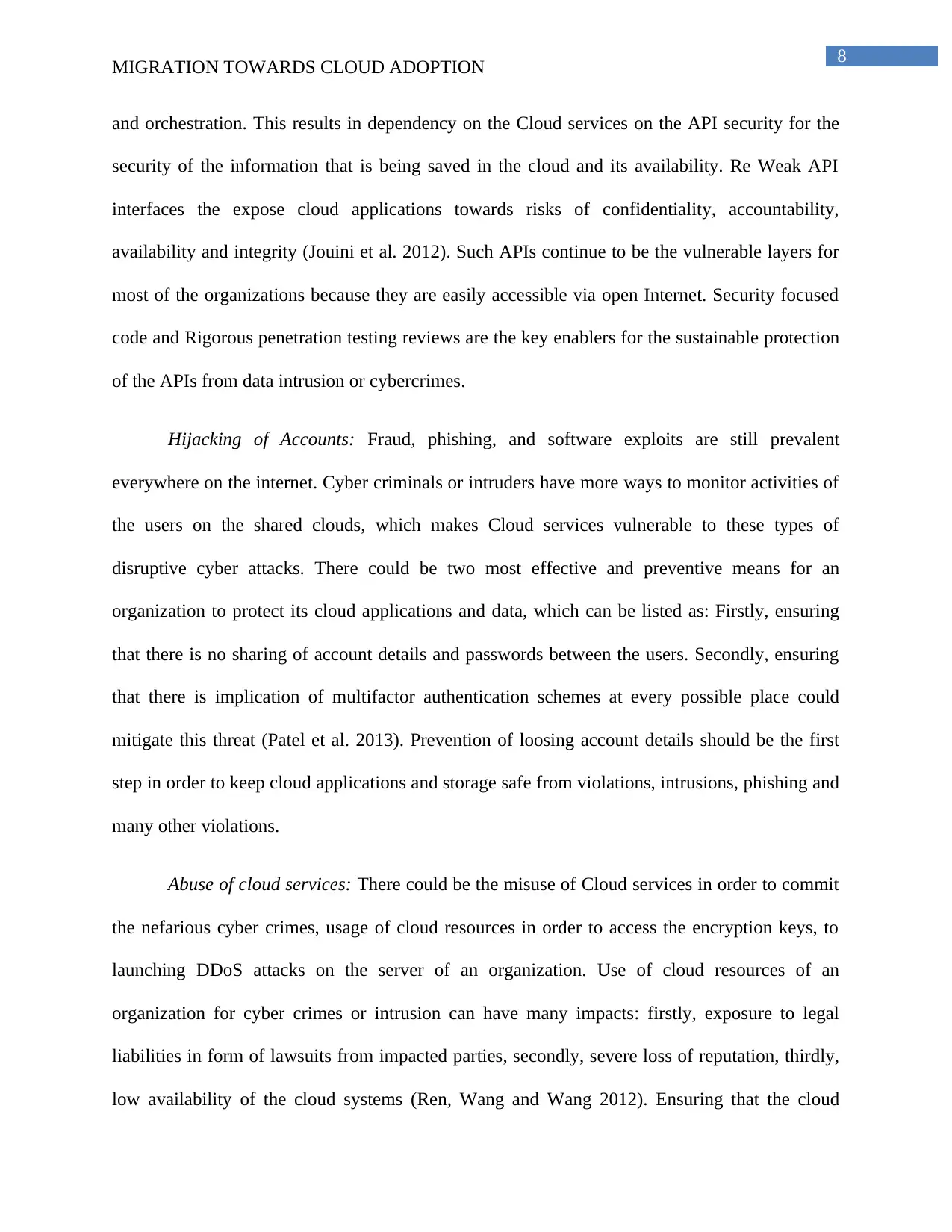
8
MIGRATION TOWARDS CLOUD ADOPTION
and orchestration. This results in dependency on the Cloud services on the API security for the
security of the information that is being saved in the cloud and its availability. Re Weak API
interfaces the expose cloud applications towards risks of confidentiality, accountability,
availability and integrity (Jouini et al. 2012). Such APIs continue to be the vulnerable layers for
most of the organizations because they are easily accessible via open Internet. Security focused
code and Rigorous penetration testing reviews are the key enablers for the sustainable protection
of the APIs from data intrusion or cybercrimes.
Hijacking of Accounts: Fraud, phishing, and software exploits are still prevalent
everywhere on the internet. Cyber criminals or intruders have more ways to monitor activities of
the users on the shared clouds, which makes Cloud services vulnerable to these types of
disruptive cyber attacks. There could be two most effective and preventive means for an
organization to protect its cloud applications and data, which can be listed as: Firstly, ensuring
that there is no sharing of account details and passwords between the users. Secondly, ensuring
that there is implication of multifactor authentication schemes at every possible place could
mitigate this threat (Patel et al. 2013). Prevention of loosing account details should be the first
step in order to keep cloud applications and storage safe from violations, intrusions, phishing and
many other violations.
Abuse of cloud services: There could be the misuse of Cloud services in order to commit
the nefarious cyber crimes, usage of cloud resources in order to access the encryption keys, to
launching DDoS attacks on the server of an organization. Use of cloud resources of an
organization for cyber crimes or intrusion can have many impacts: firstly, exposure to legal
liabilities in form of lawsuits from impacted parties, secondly, severe loss of reputation, thirdly,
low availability of the cloud systems (Ren, Wang and Wang 2012). Ensuring that the cloud
MIGRATION TOWARDS CLOUD ADOPTION
and orchestration. This results in dependency on the Cloud services on the API security for the
security of the information that is being saved in the cloud and its availability. Re Weak API
interfaces the expose cloud applications towards risks of confidentiality, accountability,
availability and integrity (Jouini et al. 2012). Such APIs continue to be the vulnerable layers for
most of the organizations because they are easily accessible via open Internet. Security focused
code and Rigorous penetration testing reviews are the key enablers for the sustainable protection
of the APIs from data intrusion or cybercrimes.
Hijacking of Accounts: Fraud, phishing, and software exploits are still prevalent
everywhere on the internet. Cyber criminals or intruders have more ways to monitor activities of
the users on the shared clouds, which makes Cloud services vulnerable to these types of
disruptive cyber attacks. There could be two most effective and preventive means for an
organization to protect its cloud applications and data, which can be listed as: Firstly, ensuring
that there is no sharing of account details and passwords between the users. Secondly, ensuring
that there is implication of multifactor authentication schemes at every possible place could
mitigate this threat (Patel et al. 2013). Prevention of loosing account details should be the first
step in order to keep cloud applications and storage safe from violations, intrusions, phishing and
many other violations.
Abuse of cloud services: There could be the misuse of Cloud services in order to commit
the nefarious cyber crimes, usage of cloud resources in order to access the encryption keys, to
launching DDoS attacks on the server of an organization. Use of cloud resources of an
organization for cyber crimes or intrusion can have many impacts: firstly, exposure to legal
liabilities in form of lawsuits from impacted parties, secondly, severe loss of reputation, thirdly,
low availability of the cloud systems (Ren, Wang and Wang 2012). Ensuring that the cloud
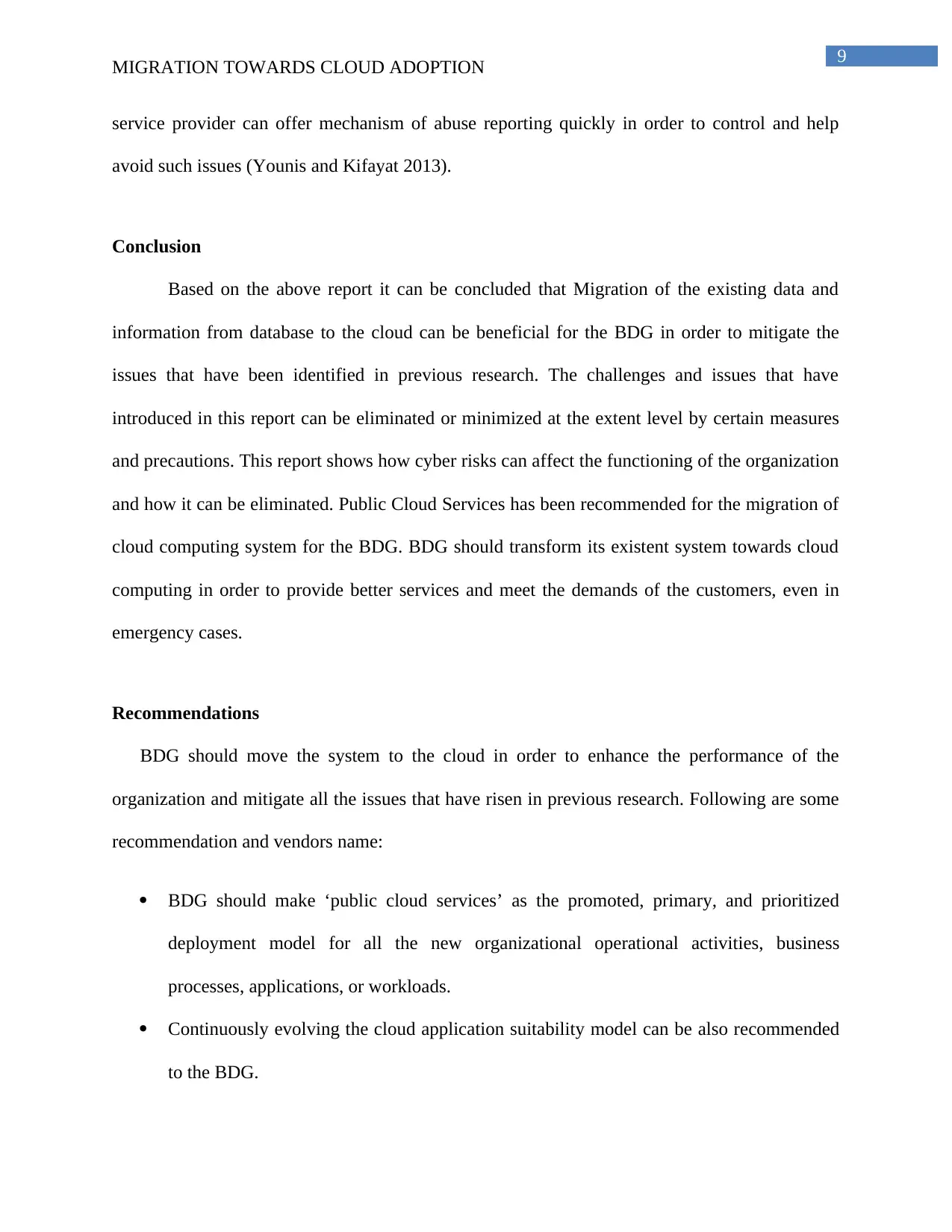
9
MIGRATION TOWARDS CLOUD ADOPTION
service provider can offer mechanism of abuse reporting quickly in order to control and help
avoid such issues (Younis and Kifayat 2013).
Conclusion
Based on the above report it can be concluded that Migration of the existing data and
information from database to the cloud can be beneficial for the BDG in order to mitigate the
issues that have been identified in previous research. The challenges and issues that have
introduced in this report can be eliminated or minimized at the extent level by certain measures
and precautions. This report shows how cyber risks can affect the functioning of the organization
and how it can be eliminated. Public Cloud Services has been recommended for the migration of
cloud computing system for the BDG. BDG should transform its existent system towards cloud
computing in order to provide better services and meet the demands of the customers, even in
emergency cases.
Recommendations
BDG should move the system to the cloud in order to enhance the performance of the
organization and mitigate all the issues that have risen in previous research. Following are some
recommendation and vendors name:
BDG should make ‘public cloud services’ as the promoted, primary, and prioritized
deployment model for all the new organizational operational activities, business
processes, applications, or workloads.
Continuously evolving the cloud application suitability model can be also recommended
to the BDG.
MIGRATION TOWARDS CLOUD ADOPTION
service provider can offer mechanism of abuse reporting quickly in order to control and help
avoid such issues (Younis and Kifayat 2013).
Conclusion
Based on the above report it can be concluded that Migration of the existing data and
information from database to the cloud can be beneficial for the BDG in order to mitigate the
issues that have been identified in previous research. The challenges and issues that have
introduced in this report can be eliminated or minimized at the extent level by certain measures
and precautions. This report shows how cyber risks can affect the functioning of the organization
and how it can be eliminated. Public Cloud Services has been recommended for the migration of
cloud computing system for the BDG. BDG should transform its existent system towards cloud
computing in order to provide better services and meet the demands of the customers, even in
emergency cases.
Recommendations
BDG should move the system to the cloud in order to enhance the performance of the
organization and mitigate all the issues that have risen in previous research. Following are some
recommendation and vendors name:
BDG should make ‘public cloud services’ as the promoted, primary, and prioritized
deployment model for all the new organizational operational activities, business
processes, applications, or workloads.
Continuously evolving the cloud application suitability model can be also recommended
to the BDG.
Secure Best Marks with AI Grader
Need help grading? Try our AI Grader for instant feedback on your assignments.
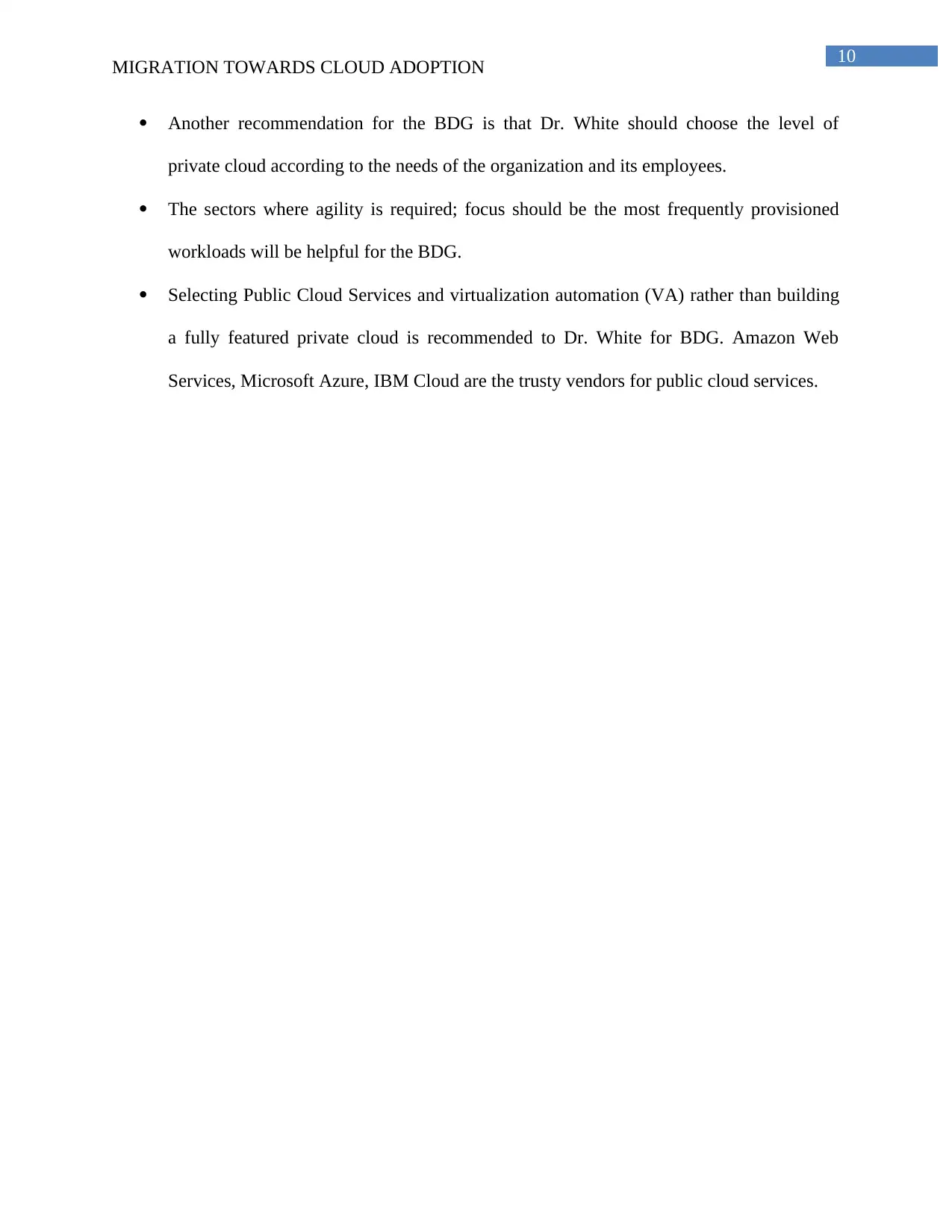
10
MIGRATION TOWARDS CLOUD ADOPTION
Another recommendation for the BDG is that Dr. White should choose the level of
private cloud according to the needs of the organization and its employees.
The sectors where agility is required; focus should be the most frequently provisioned
workloads will be helpful for the BDG.
Selecting Public Cloud Services and virtualization automation (VA) rather than building
a fully featured private cloud is recommended to Dr. White for BDG. Amazon Web
Services, Microsoft Azure, IBM Cloud are the trusty vendors for public cloud services.
MIGRATION TOWARDS CLOUD ADOPTION
Another recommendation for the BDG is that Dr. White should choose the level of
private cloud according to the needs of the organization and its employees.
The sectors where agility is required; focus should be the most frequently provisioned
workloads will be helpful for the BDG.
Selecting Public Cloud Services and virtualization automation (VA) rather than building
a fully featured private cloud is recommended to Dr. White for BDG. Amazon Web
Services, Microsoft Azure, IBM Cloud are the trusty vendors for public cloud services.
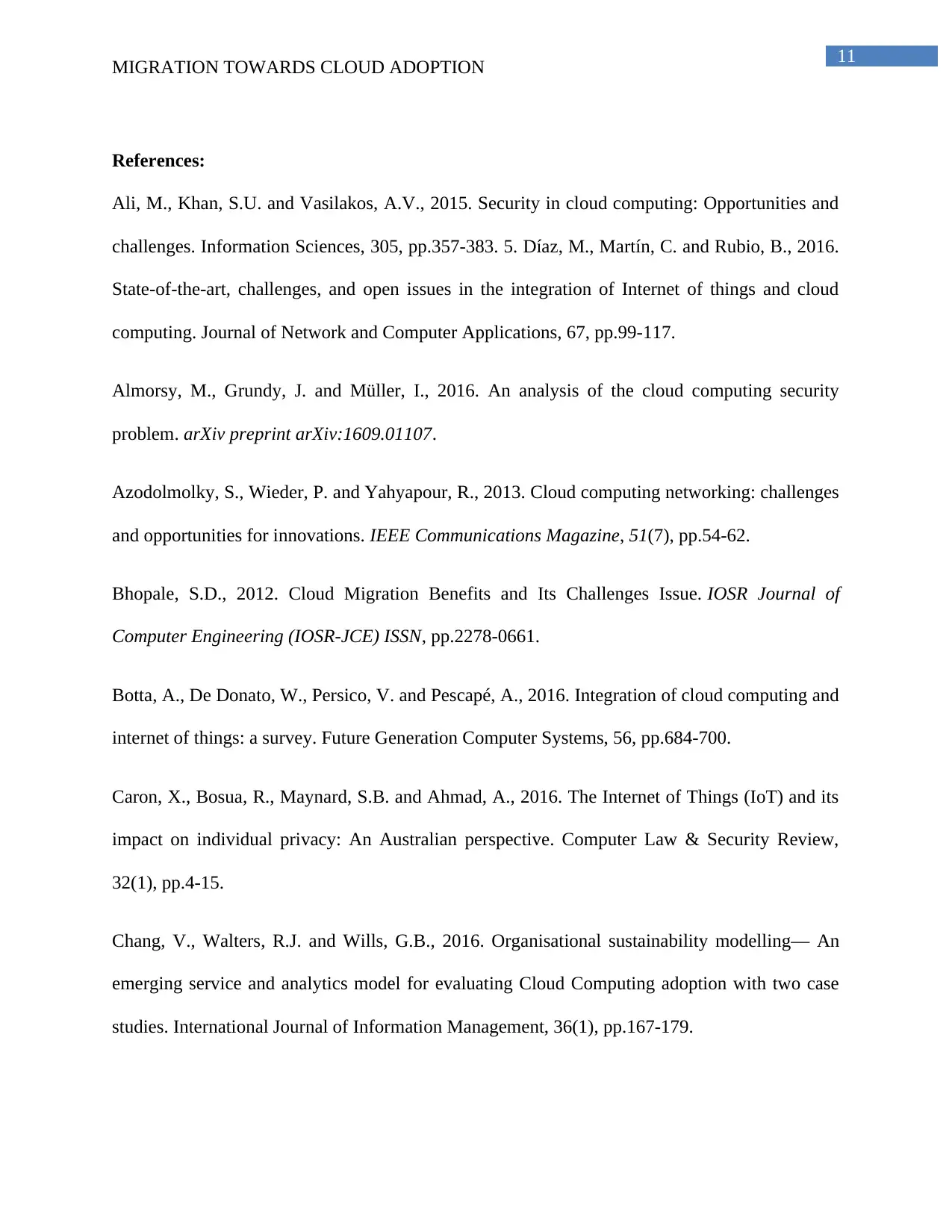
11
MIGRATION TOWARDS CLOUD ADOPTION
References:
Ali, M., Khan, S.U. and Vasilakos, A.V., 2015. Security in cloud computing: Opportunities and
challenges. Information Sciences, 305, pp.357-383. 5. Díaz, M., Martín, C. and Rubio, B., 2016.
State-of-the-art, challenges, and open issues in the integration of Internet of things and cloud
computing. Journal of Network and Computer Applications, 67, pp.99-117.
Almorsy, M., Grundy, J. and Müller, I., 2016. An analysis of the cloud computing security
problem. arXiv preprint arXiv:1609.01107.
Azodolmolky, S., Wieder, P. and Yahyapour, R., 2013. Cloud computing networking: challenges
and opportunities for innovations. IEEE Communications Magazine, 51(7), pp.54-62.
Bhopale, S.D., 2012. Cloud Migration Benefits and Its Challenges Issue. IOSR Journal of
Computer Engineering (IOSR-JCE) ISSN, pp.2278-0661.
Botta, A., De Donato, W., Persico, V. and Pescapé, A., 2016. Integration of cloud computing and
internet of things: a survey. Future Generation Computer Systems, 56, pp.684-700.
Caron, X., Bosua, R., Maynard, S.B. and Ahmad, A., 2016. The Internet of Things (IoT) and its
impact on individual privacy: An Australian perspective. Computer Law & Security Review,
32(1), pp.4-15.
Chang, V., Walters, R.J. and Wills, G.B., 2016. Organisational sustainability modelling— An
emerging service and analytics model for evaluating Cloud Computing adoption with two case
studies. International Journal of Information Management, 36(1), pp.167-179.
MIGRATION TOWARDS CLOUD ADOPTION
References:
Ali, M., Khan, S.U. and Vasilakos, A.V., 2015. Security in cloud computing: Opportunities and
challenges. Information Sciences, 305, pp.357-383. 5. Díaz, M., Martín, C. and Rubio, B., 2016.
State-of-the-art, challenges, and open issues in the integration of Internet of things and cloud
computing. Journal of Network and Computer Applications, 67, pp.99-117.
Almorsy, M., Grundy, J. and Müller, I., 2016. An analysis of the cloud computing security
problem. arXiv preprint arXiv:1609.01107.
Azodolmolky, S., Wieder, P. and Yahyapour, R., 2013. Cloud computing networking: challenges
and opportunities for innovations. IEEE Communications Magazine, 51(7), pp.54-62.
Bhopale, S.D., 2012. Cloud Migration Benefits and Its Challenges Issue. IOSR Journal of
Computer Engineering (IOSR-JCE) ISSN, pp.2278-0661.
Botta, A., De Donato, W., Persico, V. and Pescapé, A., 2016. Integration of cloud computing and
internet of things: a survey. Future Generation Computer Systems, 56, pp.684-700.
Caron, X., Bosua, R., Maynard, S.B. and Ahmad, A., 2016. The Internet of Things (IoT) and its
impact on individual privacy: An Australian perspective. Computer Law & Security Review,
32(1), pp.4-15.
Chang, V., Walters, R.J. and Wills, G.B., 2016. Organisational sustainability modelling— An
emerging service and analytics model for evaluating Cloud Computing adoption with two case
studies. International Journal of Information Management, 36(1), pp.167-179.
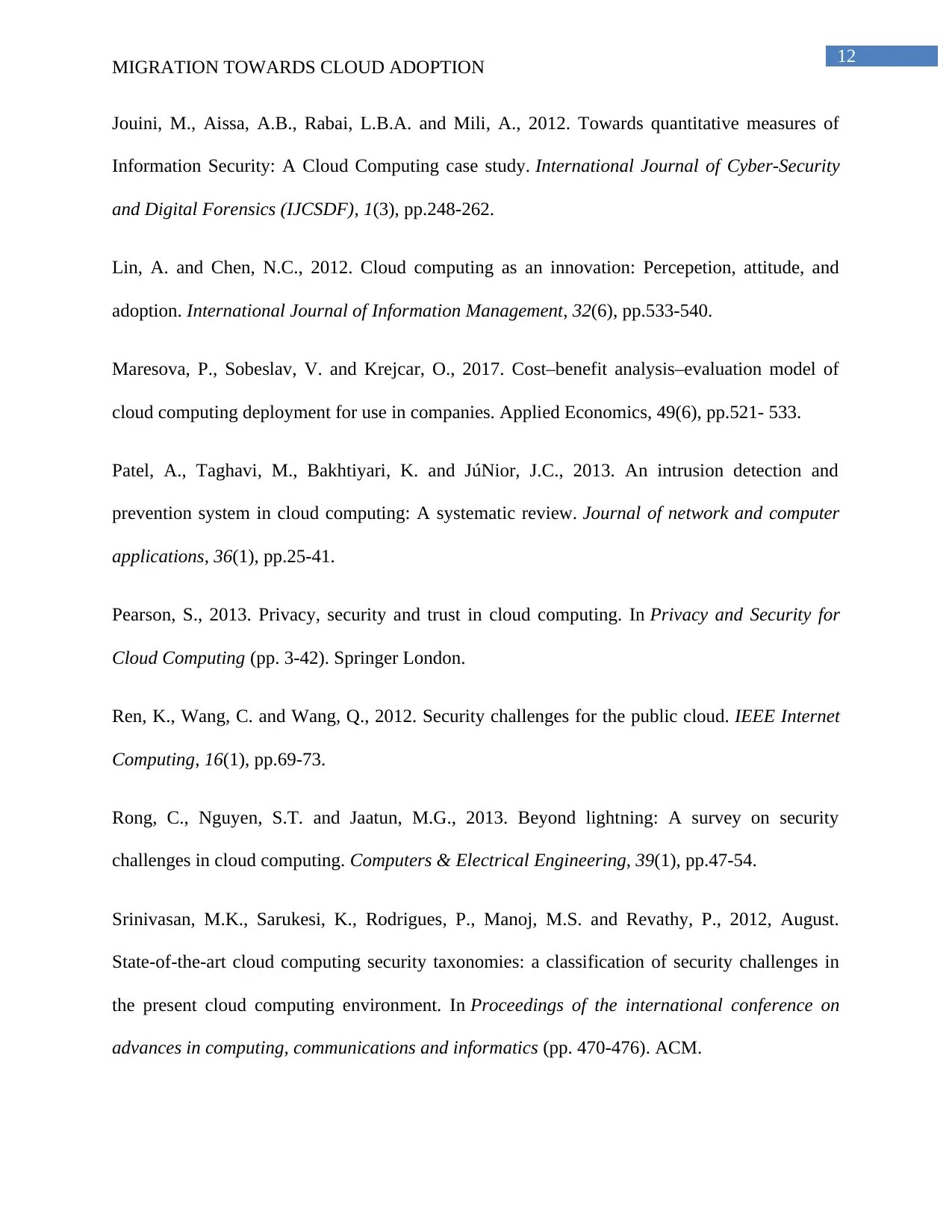
12
MIGRATION TOWARDS CLOUD ADOPTION
Jouini, M., Aissa, A.B., Rabai, L.B.A. and Mili, A., 2012. Towards quantitative measures of
Information Security: A Cloud Computing case study. International Journal of Cyber-Security
and Digital Forensics (IJCSDF), 1(3), pp.248-262.
Lin, A. and Chen, N.C., 2012. Cloud computing as an innovation: Percepetion, attitude, and
adoption. International Journal of Information Management, 32(6), pp.533-540.
Maresova, P., Sobeslav, V. and Krejcar, O., 2017. Cost–benefit analysis–evaluation model of
cloud computing deployment for use in companies. Applied Economics, 49(6), pp.521- 533.
Patel, A., Taghavi, M., Bakhtiyari, K. and JúNior, J.C., 2013. An intrusion detection and
prevention system in cloud computing: A systematic review. Journal of network and computer
applications, 36(1), pp.25-41.
Pearson, S., 2013. Privacy, security and trust in cloud computing. In Privacy and Security for
Cloud Computing (pp. 3-42). Springer London.
Ren, K., Wang, C. and Wang, Q., 2012. Security challenges for the public cloud. IEEE Internet
Computing, 16(1), pp.69-73.
Rong, C., Nguyen, S.T. and Jaatun, M.G., 2013. Beyond lightning: A survey on security
challenges in cloud computing. Computers & Electrical Engineering, 39(1), pp.47-54.
Srinivasan, M.K., Sarukesi, K., Rodrigues, P., Manoj, M.S. and Revathy, P., 2012, August.
State-of-the-art cloud computing security taxonomies: a classification of security challenges in
the present cloud computing environment. In Proceedings of the international conference on
advances in computing, communications and informatics (pp. 470-476). ACM.
MIGRATION TOWARDS CLOUD ADOPTION
Jouini, M., Aissa, A.B., Rabai, L.B.A. and Mili, A., 2012. Towards quantitative measures of
Information Security: A Cloud Computing case study. International Journal of Cyber-Security
and Digital Forensics (IJCSDF), 1(3), pp.248-262.
Lin, A. and Chen, N.C., 2012. Cloud computing as an innovation: Percepetion, attitude, and
adoption. International Journal of Information Management, 32(6), pp.533-540.
Maresova, P., Sobeslav, V. and Krejcar, O., 2017. Cost–benefit analysis–evaluation model of
cloud computing deployment for use in companies. Applied Economics, 49(6), pp.521- 533.
Patel, A., Taghavi, M., Bakhtiyari, K. and JúNior, J.C., 2013. An intrusion detection and
prevention system in cloud computing: A systematic review. Journal of network and computer
applications, 36(1), pp.25-41.
Pearson, S., 2013. Privacy, security and trust in cloud computing. In Privacy and Security for
Cloud Computing (pp. 3-42). Springer London.
Ren, K., Wang, C. and Wang, Q., 2012. Security challenges for the public cloud. IEEE Internet
Computing, 16(1), pp.69-73.
Rong, C., Nguyen, S.T. and Jaatun, M.G., 2013. Beyond lightning: A survey on security
challenges in cloud computing. Computers & Electrical Engineering, 39(1), pp.47-54.
Srinivasan, M.K., Sarukesi, K., Rodrigues, P., Manoj, M.S. and Revathy, P., 2012, August.
State-of-the-art cloud computing security taxonomies: a classification of security challenges in
the present cloud computing environment. In Proceedings of the international conference on
advances in computing, communications and informatics (pp. 470-476). ACM.
Paraphrase This Document
Need a fresh take? Get an instant paraphrase of this document with our AI Paraphraser
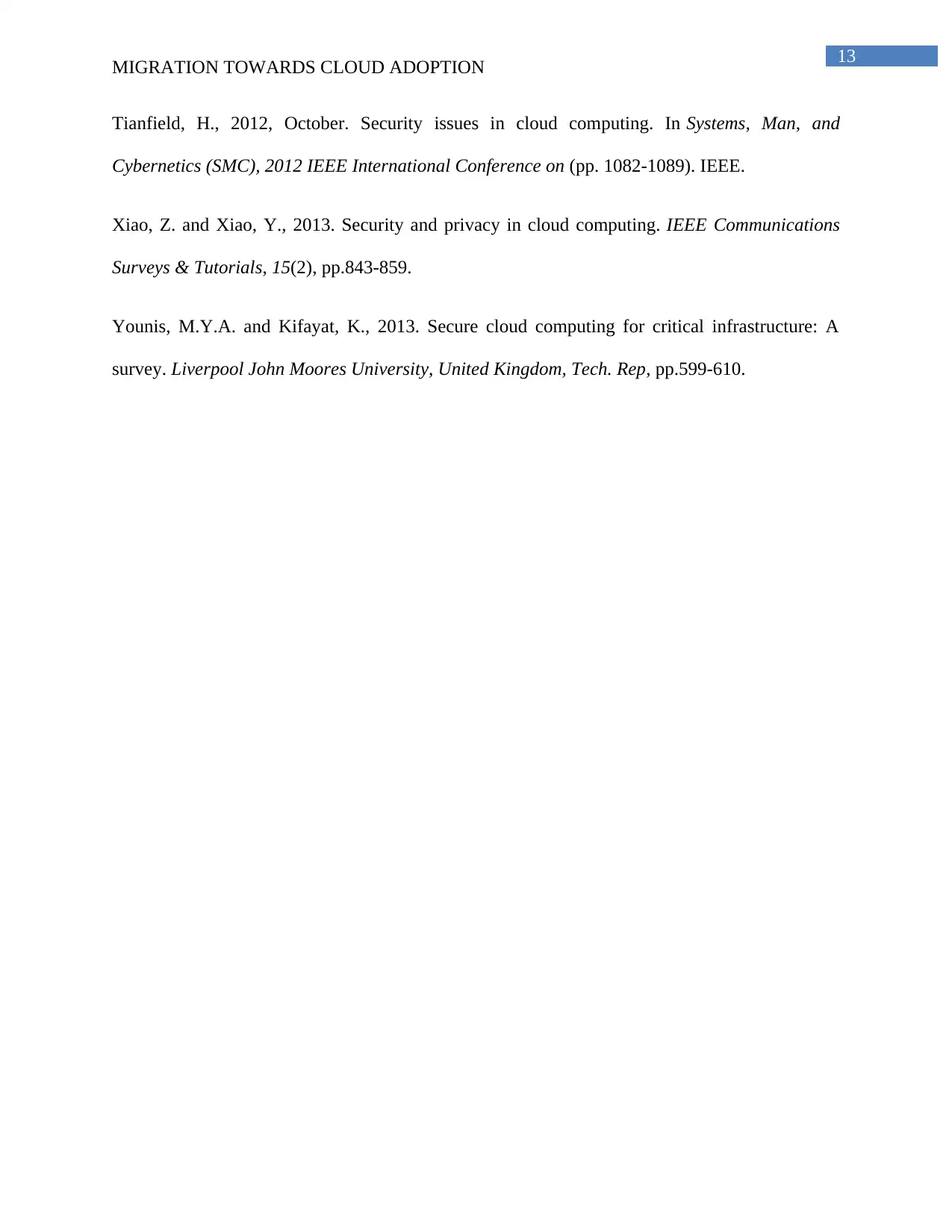
13
MIGRATION TOWARDS CLOUD ADOPTION
Tianfield, H., 2012, October. Security issues in cloud computing. In Systems, Man, and
Cybernetics (SMC), 2012 IEEE International Conference on (pp. 1082-1089). IEEE.
Xiao, Z. and Xiao, Y., 2013. Security and privacy in cloud computing. IEEE Communications
Surveys & Tutorials, 15(2), pp.843-859.
Younis, M.Y.A. and Kifayat, K., 2013. Secure cloud computing for critical infrastructure: A
survey. Liverpool John Moores University, United Kingdom, Tech. Rep, pp.599-610.
MIGRATION TOWARDS CLOUD ADOPTION
Tianfield, H., 2012, October. Security issues in cloud computing. In Systems, Man, and
Cybernetics (SMC), 2012 IEEE International Conference on (pp. 1082-1089). IEEE.
Xiao, Z. and Xiao, Y., 2013. Security and privacy in cloud computing. IEEE Communications
Surveys & Tutorials, 15(2), pp.843-859.
Younis, M.Y.A. and Kifayat, K., 2013. Secure cloud computing for critical infrastructure: A
survey. Liverpool John Moores University, United Kingdom, Tech. Rep, pp.599-610.
1 out of 14
Related Documents
Your All-in-One AI-Powered Toolkit for Academic Success.
+13062052269
info@desklib.com
Available 24*7 on WhatsApp / Email
![[object Object]](/_next/static/media/star-bottom.7253800d.svg)
Unlock your academic potential
© 2024 | Zucol Services PVT LTD | All rights reserved.





